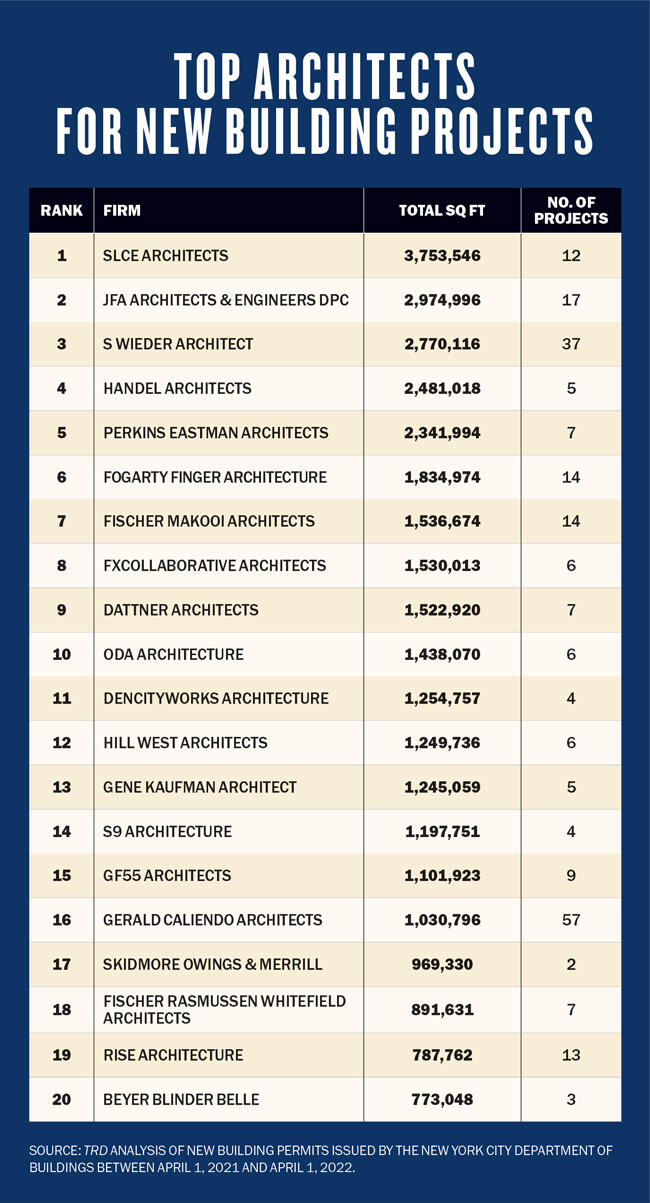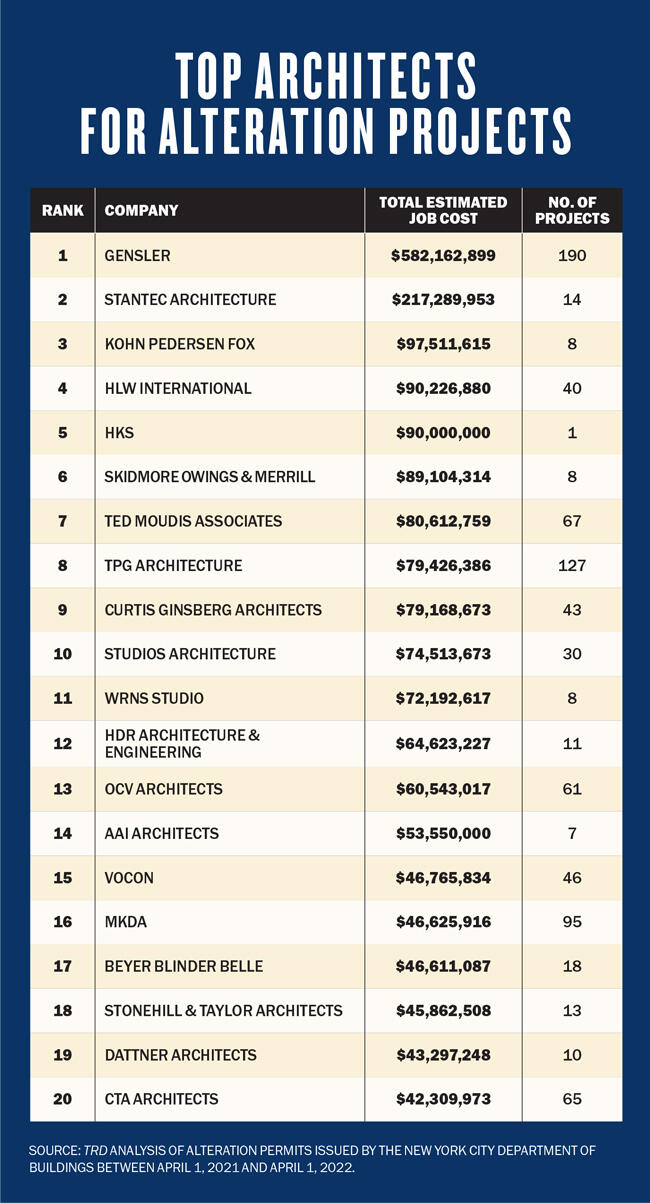When James Davidson, a partner at SLCE, walked from his Greenwich Village home to the architecture firm’s office in a changed Midtown South more than a year into the pandemic, at least one sign of normalcy remained: ongoing construction work.
“No one else is around, but the contractors are still working, because they have deadlines,” Davidson recalled.
As Covid’s lifespan approaches that of a typical development project, the city’s architecture firms have had to become experts at accounting for disrupted supply chains and extended construction timelines, remote client meetings and ever-uncertain city and state regulations in order to help developers bring their buildings to market.
“Everything is basically backlogged,” said Luigi Russo, another SLCE partner, of an extension the firm is working on for Jamestown at One Times Square. “Steel is hard to get and just not coming in fast enough.”
There have been some silver linings for those whose client base consisted of the city’s most eager developers, including the impending expiration of the popular property tax break for multifamily projects known as 421a. With little indication that state lawmakers will move to extend or replace the tax break before the end of the legislative session (at least as of press time), developers have rushed to install foundation footings by June 15, thus qualifying their projects for the incentive before it’s gone.
SLCE’s project pipeline has flowed, according to Russo, but with no replacement for the program — a blunt but generally effective tool for incentivizing developers to bring needed affordable housing to the city — a slowdown could be ahead.
Funding for apartment projects is already drying up, executives from some of the city’s biggest multifamily investors, including Slate Property Group and Greystone Capital Advisors, told The Real Deal last month.
Meanwhile, the rising cost of materials is stretching projects’ budgets.
“Imagine a contractor estimating a 2 percent cost for materials and now all of a sudden it’s up to 14 or 15 percent, for the same toilet bowl,” Davidson said.
Added to the formidable cost of development sites, even in far-flung areas of the city, the barrier to entry for developers has grown ever higher, possibly heralding a shift toward altering existing structures.
“It’s really a race to the quality of the building,” said Joseph Lauro, managing director at Gensler.
Amenity spaces, perhaps known for attracting residents to condos or rental apartments, are now the object of desire for commercial landlords hoping to draw back office tenants, according to Lauro.
“It used to be the gym in the basement,” he said. “Now it’s more about what is the food and beverage offering that gives a person another place to work.”
To help George Comfort & Sons modernize its 1960s-era Midtown office building at 135 West 50th Street, Gensler designed a sprawling, double-height lobby as well as a food and beverage space on the ground floor and a second-floor terrace cut out of the building’s curtain wall.
To find out which architecture firms won the most work over the last year, TRD analyzed applications for new buildings and major alterations submitted to the Department of Buildings in the 12-month period ending April 1. The top 20 firms for new building work were ranked by the total square footage across all projects for which they were listed as the architect of record. The top firms for alteration work were ordered according to the total estimated cost of their projects.
Ground-up gurus
SLCE Architects, a mainstay in TRD’s annual rankings of the top firms for ground-up development work, took the top spot on the new buildings list, designing over 3.7 million square feet across 12 projects during the 12 months.
A key line of business for the firm, assisted-living centers, was opened not by Covid or expiring tax breaks but by shifting demographics well before the pandemic arrived.

“People retiring, rich people on Park or Fifth Avenue from these huge apartments, and their kids have left New York — these people want to stay in their neighborhoods,” said Saky Yakas, a partner at SLCE, which was tapped by developer Hines as the architect of record on a 17-story senior-living and medical care facility under construction at the corner of 85th Street and Broadway on the Upper West Side.
In addition to work on the redevelopment of Jamestown’s One Times Square — home to the famous New Year’s Eve ball drop, but few office tenants — SLCE is designing a 22-story apartment building at 1637 First Avenue for Gary Barnett’s Extell Development. The L-shaped project, creatively angled around two buildings with holdout tenants in Barnett’s assemblage, will contain over 500 residential units.
Notable projects designed by runner-up J. Frankl Architects, or JFA, include a seven-story, 134-unit apartment building planned by developer Clipper Equities at 134 Hope Street in Williamsburg as well as Jay Group’s 17-story mixed-use project at 54-62 West 125th Street in Harlem. JFA also designed Bruman Realty’s recently completed 13-story rental building at 260 Gold Street in Downtown Brooklyn.
Brooklyn-based S. Wieder Architect, which took third place for new buildings, falling about 200,000 square feet behind JFA, designed a planned 16-story apartment and retail building at 35 Fourth Avenue in Boerum Hill, Brooklyn, and a 17-story apartment building at 185 East 109th Street in East Harlem.
S. Wieder is also working on Clipper Equities’ 351-unit residential building at 119 East 22nd Street in Flatbush and Chess Builders’ planned seven-story, mixed-use project at 218 Front Street in Vinegar Hill, Brooklyn.
Alteration aces
When it came to alteration work, two firms dominated the field — one of which may come as a surprise.
Employing more than 600 people in the New York area and approximately 6,000 across the globe, Gensler is the large architecture firm one expects in the Big Apple, with a client roster that includes major commercial real estate players like Boston Properties, Vanbarton Group and George Comfort & Sons. Its nearly 200 projects in the last year, costing developers an estimated $580 million altogether, were enough to more than double the second-place firm for alterations.
Gensler is working with Vanbarton on its vision for an office-to-residential conversion at 160 Water Street in the Financial District, which Vanbarton put on the market in September amid an enduring shift toward remote work and a dearth of available apartments in the city.

The runner-up in the alterations category, with $217 million worth of work, was Stantec Architecture, which benefited from securing substantial public works projects, including renovations of the Brooklyn Municipal Building in Downtown Brooklyn and public schools such as the Washington Heights Expeditionary Learning School and P.S. 171 in Astoria.
Kohn Pedersen Fox, one of the largest architecture firms in the city and No. 3 on the renovations list, has plenty on its plate, including building out space for Facebook at 50 Hudson Yards, where the social media giant has taken 1.2 million square feet, of the building’s nearly 3 million, for office space.
With 50 Hudson Yards expected to open in the coming months, much of that work is now in the rearview mirror. When Gensler’s Lauro looks ahead, his gaze falls just a bit south of Hudson Yards, near the northern end of the High Line, as one of Manhattan’s next emerging areas for developers.
On the East Side, Lauro predicts that upgrades to a series of “good but not great” buildings along the Third Avenue corridor will drive both tenancy and return on investment.
“The developers who have come to us like to think of their buildings being completed after all of this is behind us,” said Davidson of SLCE, referring to the pandemic. “We look forward to the Roaring Twenties.”
